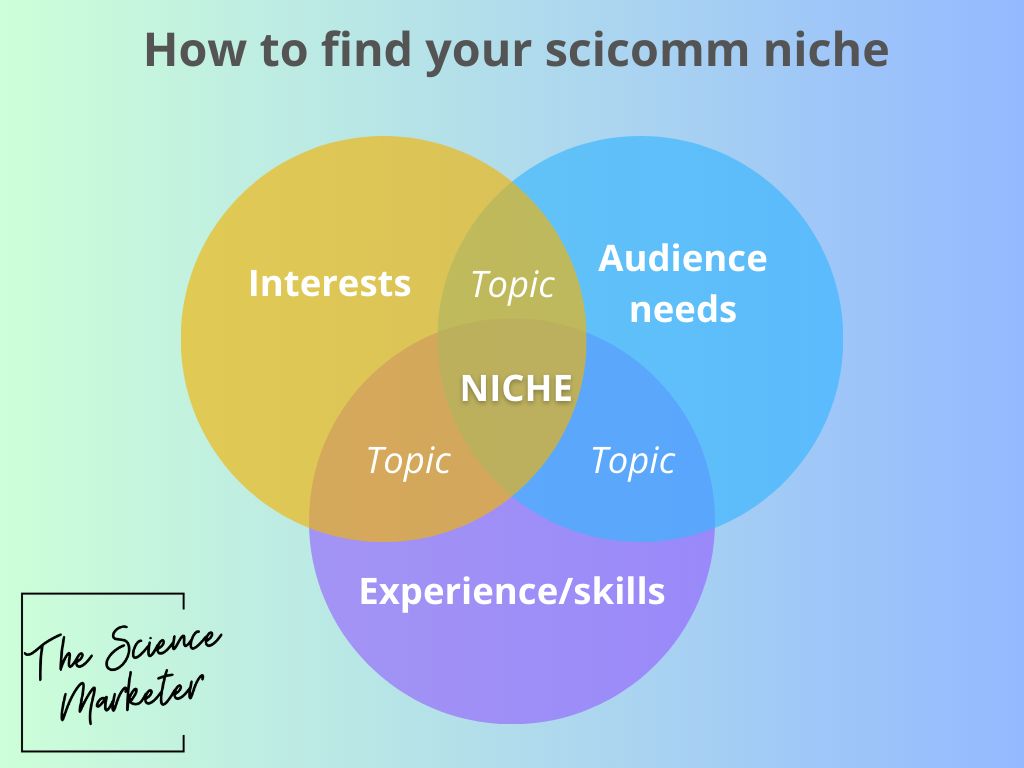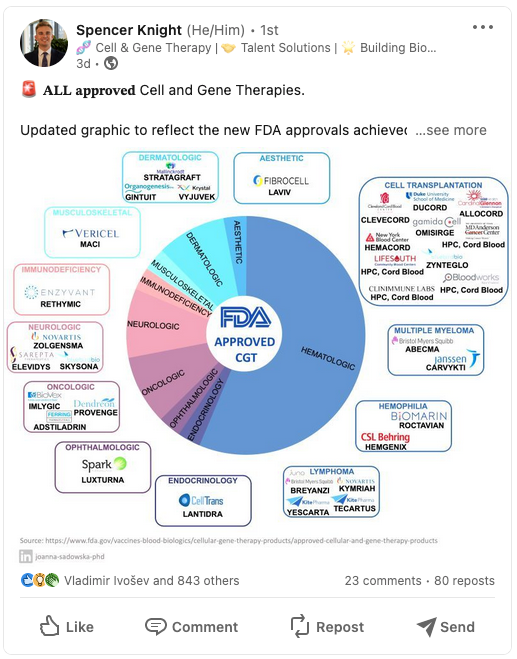In today's chaotic and overloaded world, the field of science writing and marketing has turned into a fierce battleground.
With an avalanche of information vying for attention, scicomm professionals face the daunting task of standing out and leaving a lasting impact.
But fear not, there is a powerful strategy that can help you conquer this challenge: finding your niche.
Whether you're an aspiring science writer looking to establish your name or a marketer seeking to reach a specific audience, discovering and embracing a niche can be a game-changer.
But first, let's strip it down to the basics.
What the hell is a niche?
A niche is like finding that sweet spot where your interests meet the needs of a particular group of people.
A niche can be as narrow as a group of a few hundred people, or as broad as an audience of several million.
It's not simply a topic, but rather the convergence of a subject with a specific audience.
For instance, "cooking" is a broad topic, but "gluten-free cooking for vegans" is a niche that hits the sweet spot.
Now, let me share a personal story.
When I kick-started my science communication career, I set my sights on biotech professionals in France, with an interest in following the news from this industry.
This niche encompassed a modest 50,000 to 100,000 people, a perfect sweet spot to launch a niche media platform.
And guess what?
I later expanded to the whole European scene, which led to the birth of Labiotech.eu, which targets a similar but much larger niche.
I’ll explain later how I came up with choosing this niche and how you can do the same, but for now, let’s discuss the advantages of embracing a niche.
Why identifying a niche is a competitive advantage?
One common rookie mistake is attempting to please everyone or covering every damn topic under the sun.
We science communicators are curious creatures, passionate about a gazillion subjects, so it's tempting to fall into that trap.
But here's the truth bomb: if you want to stand out and create a real impact, you must find that narrow zone where your passion aligns with a specific audience.
That's the secret sauce that sets you apart in a crowded market and helps you build a tribe of devoted fans.
Let me give you an example.
John Carroll, the godfather of biotech editors, ruled the editorial strategy of Fierce Biotech for years.
But he didn't stop there; he went on to create Endpoints News as an alternative to his former employer.
And you know what?
Endpoints is now one of the leading biotech media outlets, rivaling Fierce in terms of audience size.
And that’s definitely thanks to Carroll's loyal following, who recognized his expertise and followed him to his new venture from day one.
Building this kind of recognition takes time, but it pays off.
Specializing in a niche gives you the power to create unique and valuable content.
You can dive deep into lesser-known topics or emerging trends within your chosen niche, providing in-depth analysis, insights, and contributions that advance knowledge and understanding in your field.
This not only positions you as a thought leader but also adds substantial value to your work.
Can a niche limit you in your future career options?
If this is a concern for you, let me tell you this: it shouldn't deter you from building deep expertise in a specific field.
I've witnessed many science writers transition from one niche to another, and most of the time, their past experience proved to be a valuable asset in the new niche.
It's also common to see folks jump from science communication to marketing (or vice versa), and having profound knowledge in a particular field can pay dividends down the road.
In my humble opinion, it's always easier to start narrow and then expand your horizons.
So, choosing a niche early on in your career is not a risk; it's a damn advantage.
How do you find your niche?
Many creators get lured by methods that only look at potential traffic without considering their own interests and relevance to that niche.
But you know what?
Passion is the freaking key.
You'll never find success in a niche that doesn't fire you up, no matter how many people are interested in it.
That's why it's crucial to choose a niche that ignites your soul, that motivates you to create content over and over again.
And don't underestimate the size of a niche - even the tiniest ones can attract a fiercely loyal audience.
Take the example of Maurizio Leo, a former engineer who set out to create a blog about making homemade bread (this is outside of science, but it’s just to prove a point).
Today, his newsletter has over 100,000 subscribers and his cookbook has become a New York Times bestseller.
And he managed to do all of that just talking about bread!
Just goes to show that any passion can lead to great things.
The key to choosing a niche is to identify those three key elements:
- Your skills and experience
- Your interests
- A need you've identified
The crossing of those 3 criteria forms a specific niche, as this figure shows:

To find your own niche, start by establishing a list of items for each of the 3 elements.
Be as descriptive as possible, and don't be afraid to include subjects that seem totally unrelated (that's where the magic happens).
In my case, the list might look something like this:
1/ Experience:
- running a small business
- creating online content
- running a digital media/newsletter
- online marketing
2/ Interests:
- how the creative process works
- personal development
- writing
- sciences
- economy and history
3/ Needs:
- PhD students looking for a career in communication and marketing
- Science marketers looking for resources
- Science writers looking for career advice
Once you have your list, choose an option for each category and try to combine them.
Combining two categories, for example, "Experience" and "Interests", can give you ideas for topics.
By combining the three categories, you'll end up with a unique niche that matches your skills, interests and market needs.
The layering method is particularly well-suited to those who find it difficult to choose between numerous options.
Nevertheless, it requires you to identify an existing need before you can use it effectively.
In my case, I’m lucky that the different needs I identified kind of overlap with each other.
It means I can start with one specific group in mind (science marketers), but make my content fit to overlapping audiences (PhD and science writers).
How to put it into practice
The choice of a niche is only the first step.
To make it work, you need to get associated with your chosen niche.
And to do that, you need to consistently create content specific to this niche.
Examples are worth a thousand words, so let me show you someone who does this incredibly well.
Spencer Knight is a recruiter in the biotech field.
His secret to success: specializing in the Cell & Gene Therapy (CGT) niche.
He's really the CGT guy and you can even see it at the top of his LinkedIn profile:

To make sure he's associated with this niche, Spencer shares a lot of cell and gene therapy related content every day.
And it's really useful content for anyone working in the field, like this recent post:

As he's well known for his knowledge of the field, you can bet that biotech executives will be turning to him when it comes to recruiting top talent in this field.
Whether you write about science or market a science-related service, this is how you can use a niche to your advantage.
The ever-evolving nature of your niche
Your niche is not a stagnant entity.
It's a living, breathing organism that demands your attention, care, and most importantly, evolution.
You see, the world around us is in a constant state of flux.
Trends come and go, new discoveries emerge, and the needs of your audience transform like a chameleon on steroids.
To stay relevant and maintain your edge, you must be willing to adapt and evolve your niche.
So, how do you evolve your niche?
It starts with a healthy dose of curiosity and a willingness to explore uncharted territories.
Dive into emerging trends and keep your finger on the pulse of your field.
Evolving your niche doesn't mean abandoning everything you've built.
It's about building upon your existing foundation and infusing it with fresh perspectives and innovative ideas.
It's an ongoing process—a dance between staying true to your core values and embracing the winds of change.
It requires constant learning, experimentation, and a willingness to let go of what no longer serves you.
But here's the beauty of it all: as you evolve your niche, you not only elevate your own game but also inspire those around you.
Your audience will witness your growth, your dedication to excellence, and they'll be damn grateful for it.
So, don't fear the evolution of your niche.
Embrace it with open arms and an insatiable hunger for progress.





